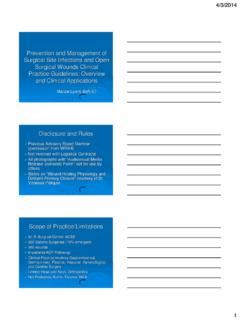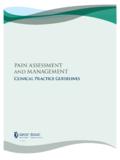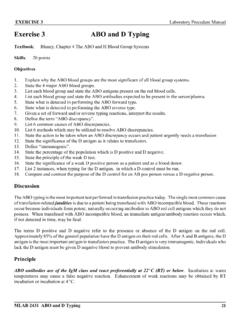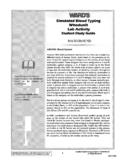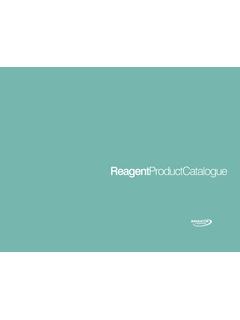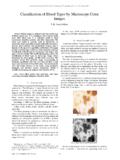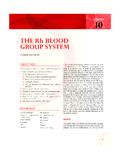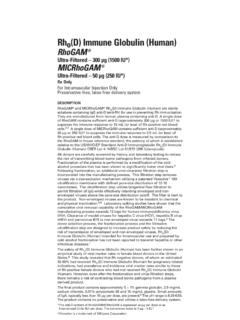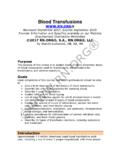Transcription of June 2015, 1 of 14 NEONATAL CLINICAL PRACTICE …
1 NEONATAL CLINICAL PRACTICE GUIDELINE Title: Jaundice and Hyperbilirubinemia in the Newborn: Assessment and Management Approval Date: June 2015, Revised February 2018 Pages: 1 of 14 Approved by: NEONATAL Patient Care Teams, HSC & SBH Maternal-Newborn Committee Child Health Medicine Patient Care Team Child Health Standards Committee Supercedes: HSC: SBH #021 PURPOSE AND INTENT: To promote optimal assessment, diagnosis, management and follow-up of the newborn with the potential for and / or hyperbilirubinemia. To provide a rapid non-invasive method of obtaining NEONATAL bilirubin levels. Note: All recommendations are approximate guidelines only and practitioners must take in to account individual patient characteristics and situation. Concerns regarding appropriate treatment must be discussed with the attending neonatologist.
2 PRACTICE OUTCOME: Approximately 60% of normal newborns become clinically jaundiced in the first week of life. While the majority of these newborns have physiologic jaundice, vigilant assessment and follow-up is important to prevent severe hyperbilirubinemia and kernicterus. The Canadian Paediatric Society recommends universal screening for hyperbilirubinemia for all newborns in the early post birth period. DEFINITIONS: Hyperbilirubinemia in the newborn: Excess serum bilirubin in the newborn due either to overproduction of bilirubin, as in excessive destruction of erythrocytes, or to reduction in glucuronide conjugation in the liver. If a high level of bilirubinemia is left untreated, kernicterus may occur as a result of free unconjugated bilirubin entering the brain tissue and causing neurotoxic damage. Standard Phototherapy: Light therapy with a single light source that can deliver a minimum of 30 W/cm2/nm (refer to information provided by light manufacturer).
3 Note: In the current Canadian Paediatric Society (CPS) guidelines, this is referred to as intensive phototherapy) Intensive Phototherapy: Light therapy that covers a minimum of 80% of the infant s skin surface area using one or more light sources that can deliver a minimum of 30 W/cm2/nm. This usually requires two light sources. Transcutaneous bilirubin (TcB) meter: A hand held meter that provides an estimate of circulating bilirubin, obtained by making calculations which measure the difference between bilirubin in the skin and subcutaneous tissue and minimizes the impact of melanin (skin color) on the transcutaneous assessment. The result is expressed as the TcB . The measurement range is 0 to 340 mol/L. An average of three measurements are used. For meter operation, see the Standard Operating Procedures (HSC) for Draeger Jaundice Meter or the Specialty Nursing Procedure Draeger Jaundice Meter (SBH).
4 Total Serum Bilirubin (TSB): Total amount of bilirubin in the blood determined by sending a blood sample to the laboratory. Direct Bilirubin (DBIL): In the liver, bilirubin is conjugated with glucuronic acid by the enzyme glucuronyltransferase, making it soluble in water. The conjugated version is also often called "direct" bilirubin. Elevation in conjugated (direct) bilirubin level is pathologic. Prompt evaluation is necessary for NEONATAL cholestasis including biliary atresia. Only a total bilirubin will be reported unless a direct bilirubin is specifically requested. Title: Jaundice and Hyperbilirubinemia in the Newborn: Assessment and Management Page: 2 of 14 Direct Antiglobulin Test (DAT): A blood sample result that may be used to diagnose hemolytic disease of the newborn due to incompatibility between the blood type of a mother and infant (previously referred to as Direct Coombs Test).
5 GUIDELINES: Universal Screening of All Newborns Screen all newborns of any gestational age, who have not received phototherapy or an exchange transfusion, for the development of hyperbilirubinemia using the TcB monitor, initially between 24-30 hours and every am thereafter until discharged from hospital. If admitted to a NEONATAL intensive care unit, continue for the first 7 days unless otherwise ordered by infant s prescribing practitioner. Use infant s forehead as primary site for TcB reading unless extensively bruised and discolored; use infant s sternum as secondary site if required, or if infant has been discharged and exposed to ambient sunlight. If TcB reading appears inconsistent with CLINICAL assessment, use CLINICAL judgment to order TSB and/or request care provider assessment. When the TcB meter display shows _ _ _ , the estimated bilirubin exceeds 340 mol/L.
6 Record such results as > 340 and notify care provider immediately for direction related to TSB and/or phototherapy. If baby appears jaundiced < 24 hours of age, screen using TcB. Notify infant s care provider of result if TcB reading plots in high risk zone of Nomogram for Designation of Risk Based on Hour Specific Serum Bilirubin or Transcutaneous Value (Appendix B) and obtain order for TSB and DAT. For infants 35 weeks gestational age or more and on the well-newborn mother baby unit, plot TcB reading on the Nomogram for Designation of Risk Based on Hour Specific Serum Bilirubin or Transcutaneous Value (Appendix B or found at website: ). Determine next steps based on the risk zone as follows, if the infant has not previously been on phototherapy. High Risk Zone: o Do TSB and Direct Antiglobulin Test (Coombs) immediately (if DAT not previously done).
7 O Plot the TSB result on Appendix C (Phototherapy Implementation Threshold Graph) to determine need for phototherapy or refer to o Notify infant care provider of results, including the risk threshold line used on the graph on Appendix C, to determine if phototherapy is required and when a repeat bilirubin measurement should be obtained. A TcB can be done for repeat testing if baby is NOT on phototherapy. High Intermediate Risk Zone: o 38 weeks gestational age: o Notify infant s care provider. o Repeat TcB in 24 hours while in hospital. o When preparing for discharge, contact infant s care provider for direction regarding follow-up based on other jaundice risk factors. o If a bilirubin trajectory needs to be established, use TcB for repeat measurement. o < 38 weeks gestational age: o Notify infant s care provider if TcB plots within phototherapy range (per Appendix C using the appropriate risk threshold line or per ).
8 O Care provider may order a TSB and DAT (if DAT not already done) and/or CBC, reticulocyte count, and/or G6PD level to determine whether hemolysis is likely and whether to initiate phototherapy. o Alternatively, care provider may choose to monitor TcB more frequently to evaluate whether the rise in TcB may be indicative of hemolysis. o If the TcB is not within phototherapy range, repeat TcB in 24 hours. o When preparing for discharge, contact infant s care provider for direction regarding follow-up based on other jaundice risk factors. Title: Jaundice and Hyperbilirubinemia in the Newborn: Assessment and Management Page: 3 of 14 o If preparing for discharge for infants between 37-37+6 weeks gestation, and a bilirubin trajectory needs to be established prior to discharge, use TcB for repeat measurements at intervals requested by provider (typically every 10-24 hrs) Low Intermediate Risk Zone: o Ongoing CLINICAL assessment.
9 O Repeat TcB q 24 hrs in am while in hospital o Repeat TcB/TSB if clinically indicated post-discharge. Low Risk Zone: o Ongoing CLINICAL assessment. o Repeat TcB q 24 hrs in am while in hospital o Repeat TcB/TSB if clinically indicated post-discharge. I For infants less than 35 weeks gestational age, plot the TcB result on the graph in Appendix D specific to their birthweight. If the value plots in the phototherapy range, inform care provider to obtain an order for a TSB. Make decisions regarding NEONATAL bilirubin therapy (phototherapy, exchange transfusion) only on TSB results. Note: If TcB level is close to treatment / phototherapy levels, do a TSB. Refer to Appendixes C, D and E. Ensure all information regarding TSB and TcB levels is communicated appropriately to the most responsible care provider. Refer to Appendix F (Communication re High Intermediate or High Risk Zone) and Appendix G (Communication re Phototherapy).
10 Assessment and Management If breastfeeding, assist mothers to breastfeed at least 8 times per day. If extra fluids are required for dehydration or weight loss, expressed breast milk or infant formula should be given as outlined in the WRHA Breastfeeding Guidelines for the Healthy Term Infant. Provide intravenous fluid supplementation to infants under phototherapy who are approaching Total Serum Bilirubin (TSB) exchange transfusion levels (see Appendix E for TSB Exchange Transfusion Levels Graph). Continue breastfeeding. Consult lactation support nurses if required. Visually assess the newborn for CLINICAL features of jaundice by blanching the infant s skin on their forehead with a thumb to determine the degree of yellow discoloration that is present after the pressure is released. Inspect palms and soles of feet, oral mucosa and conjunctiva.


